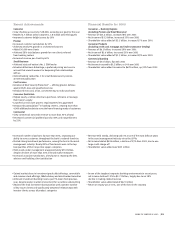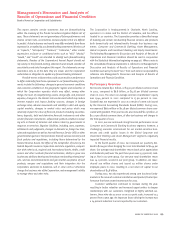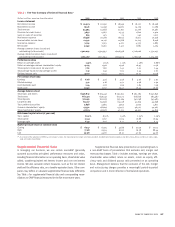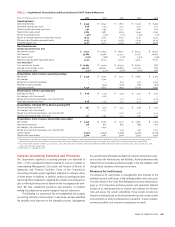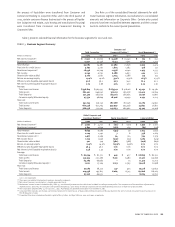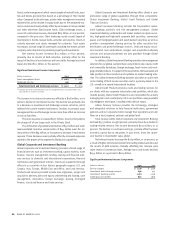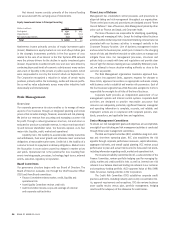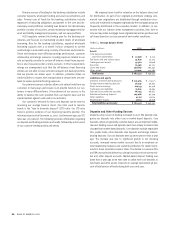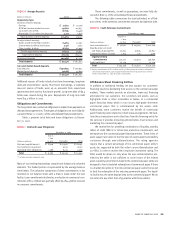Bank of America 2002 Annual Report Download - page 32
Download and view the complete annual report
Please find page 32 of the 2002 Bank of America annual report below. You can navigate through the pages in the report by either clicking on the pages listed below, or by using the keyword search tool below to find specific information within the annual report.
30 BANK OF AMERICA 2002
Principal Investing
Principal Investing within the Equity Investments segment, discussed
in more detail in Business Segment Operations, is comprised of a
diversified portfolio of investments in privately held and publicly
traded companies at all stages, from start-up to buyout. Some of
these companies may need access to additional cash to support
their long-term business models. Market conditions as well as com-
pany performance may impact whether such funding is sourced from
private investors or via capital markets. As of December 31, 2002,
we had non-public investments of $5.4 billion.
Trading Assets and Liabilities
The Corporation engages in a variety of trading-related activities that
are either for clients or our own accounts. The management process
related to the trading positions is discussed in detail in the Market
Risk Management section beginning on page 49. Positions recorded
on the balance sheet are valued at fair value and the majority of the
positions are based on or derived from actively quoted markets prices
or rates. Valuations for trading account assets and liabilities are
obtained from actively traded markets where valuations can be
obtained from quoted market prices or observed transactions. The
most significant factor affecting the valuation of trading assets or
liabilities is the lack of liquidity, where trading in a position or a mar-
ket sector has slowed significantly or ceased and quotes may not be
available. Liquidity situations generally are triggered by the market’s
perception of credit regarding a single company or a specific market
sector, for example airlines or sub-prime. In these instances, valua-
tions are derived from the limited market information available and
other factors, principally from reviewing the issuer’s financial state-
ments and changes in credit ratings made by one or more of the rating
agencies. Valuations for derivative assets and liabilities not traded
on an exchange, or over the counter, are obtained using
mathematical models that require inputs of external rates and prices
to generate continuous yield or pricing curves used to value the
position. This “pricing risk” is greater for positions with either option-
based or longer dated attributes where inputs are not readily available
and model-based extrapolations of rate and price scenarios are used
to generate valuations. In these situations, this risk is mitigated
through the use of valuation adjustments.
Accrued Taxes
Management estimates tax expense based on the amount it expects to
owe various tax authorities. Taxes are discussed in more detail in Note
18 of the consolidated financial statements. Accrued taxes represent
the net estimated amount due or to be received from taxing authori-
ties. In estimating accrued taxes, management assesses the relative
merits and risks of the appropriate tax treatment of transactions tak-
ing into account statutory, judicial and regulatory guidance in the
context of our tax position.
Goodwill
The nature and accounting for goodwill is discussed in detail in Notes 1
and 9 of the consolidated financial statements. Assigned goodwill is
subject to a market value recoverability test that records a loss if the
value of goodwill is less than the amount recorded in the financial
statements. Estimating the value of goodwill requires assumptions
regarding future cash flows and comparable business valuations.
Accounting Standards
Our accounting for hedging activities, securitizations and off-balance
sheet special purpose entities requires significant judgment in inter-
preting and applying the accounting principles related to these mat-
ters. Judgments include, but are not limited to, the determination of
whether a financial instrument or other contract meets the definition
of a derivative in accordance with Statement of Financial Accounting
Standards No. 133, “Accounting for Derivative Instruments and Hedging
Activities,” (SFAS 133) and the applicable hedge criteria, the accounting
for the transfer of financial assets and extinguishments of liabilities in
accordance with Statement of Financial Accounting Standards No. 140,
“Accounting for Transfers and Servicing of Financial Assets and
Extinguishments of Liabilities – a replacement of FASB Statement
No. 125” (SFAS 140) and the determination of when certain special
purpose entities should be consolidated in the Corporation’s balance
sheet and statement of income. For a more complete discussion of these
principles, see Notes 1, 5 and 8 of the consolidated financial statements.
The remainder of management’s discussion and analysis of the
Corporation’s results of operations and financial position should be
read in conjunction with the consolidated financial statements and
related notes presented on pages 72 through 111. See Note 1 for
Recently Issued Accounting Pronouncements.
Business Segment Operations
We provide to our clients both traditional banking and nonbanking
financial products and services through four business segments:
Consumer and Commercial Banking, Asset Management, Global
Corporate and Investment Banking and Equity Investments.
In managing our four business segments, we evaluate results
using both financial and non-financial measures. Financial measures
consist primarily of revenue, net income and shareholder value
added. Non-financial measures include, but are not limited to, market
share and customer satisfaction. Total revenue includes net interest
income on a taxable-equivalent basis and noninterest income. The
net interest income of the business segments includes the results of a
funds transfer pricing process that matches assets and liabilities
with similar interest rate sensitivity and maturity characteristics. Net
interest income also reflects an allocation of net interest income gen-
erated by certain assets and liabilities used in our asset and liability
management (ALM) activities.
From time to time we refine the business segment strategy and
reporting. As we continued to refine our business segment strategy in
2001, we moved a portion of our thirty-year mortgage portfolio from
the Consumer and Commercial Banking segment to Corporate Other.
The mortgages designated solely for ALM activities were moved to
Corporate Other to reflect the fact that management decisions regard-
ing this portion of the mortgage portfolio are driven by corporate ALM
considerations and not by the business segments’ management. In
the first quarter of 2002, certain commercial lending businesses in





